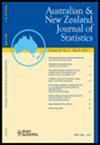稀疏伽玛尺度混合模型的检测边界
IF 0.8
4区 数学
Q3 STATISTICS & PROBABILITY
引用次数: 1
摘要
我们导出了单侧版本的伽马尺度混合模型的检测边界,其中污染成分的平均值大于已知的参考分布。我们还推导了一种自适应测试,该测试能够在检测局部替代方案方面几乎一致地获得最佳性能。本文章由计算机程序翻译,如有差异,请以英文原文为准。
Detection boundary for a sparse gamma scale mixture model
We derive the detection boundary for the one-sided version of the gamma scale mixture model where the contaminating component has a larger mean than the known reference distribution. We also derive an adaptive test which is able to almost uniformly attain the best possible performance in terms of detection of local alternatives.
求助全文
通过发布文献求助,成功后即可免费获取论文全文。
去求助
来源期刊
CiteScore
1.30
自引率
9.10%
发文量
31
审稿时长
>12 weeks
期刊介绍:
The Australian & New Zealand Journal of Statistics is an international journal managed jointly by the Statistical Society of Australia and the New Zealand Statistical Association. Its purpose is to report significant and novel contributions in statistics, ranging across articles on statistical theory, methodology, applications and computing. The journal has a particular focus on statistical techniques that can be readily applied to real-world problems, and on application papers with an Australasian emphasis. Outstanding articles submitted to the journal may be selected as Discussion Papers, to be read at a meeting of either the Statistical Society of Australia or the New Zealand Statistical Association.
The main body of the journal is divided into three sections.
The Theory and Methods Section publishes papers containing original contributions to the theory and methodology of statistics, econometrics and probability, and seeks papers motivated by a real problem and which demonstrate the proposed theory or methodology in that situation. There is a strong preference for papers motivated by, and illustrated with, real data.
The Applications Section publishes papers demonstrating applications of statistical techniques to problems faced by users of statistics in the sciences, government and industry. A particular focus is the application of newly developed statistical methodology to real data and the demonstration of better use of established statistical methodology in an area of application. It seeks to aid teachers of statistics by placing statistical methods in context.
The Statistical Computing Section publishes papers containing new algorithms, code snippets, or software descriptions (for open source software only) which enhance the field through the application of computing. Preference is given to papers featuring publically available code and/or data, and to those motivated by statistical methods for practical problems.

 求助内容:
求助内容: 应助结果提醒方式:
应助结果提醒方式:


